Theistic Satanism
Theistic Satanism or spiritual Satanism is an umbrella term for religious beliefs that consider Satan as an objectively existing deity, supernatural being or force worthy of worship and supplication, whom individuals may contact, convene and even praise, rather than just an archetype, metaphor, symbol or idea as in LaVeyan Satanism.[1] The individual belief systems under this umbrella are practiced by loosely affiliated or independent groups and cabals. Another characteristic of theistic Satanism is the use of ceremonial magic.
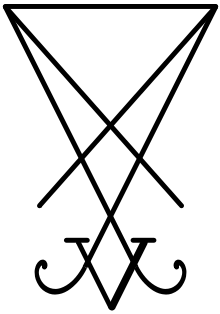
The history of theistic Satanism, as an existing spiritual path practiced by people, is obscured by a number of groups accused of being devil-worshippers who asserted that they were not, such as in the witch trials in Early Modern Europe. Most actual theistic Satanist religions exist in relatively new models and ideologies, many of which claim to be independent of the Abrahamic religions.
Currents within recent and contemporary theistic Satanism
The internet has increased awareness of different beliefs among Satanists, and has led to more diverse groups, but Satanism has always been a pluralistic and decentralised religion.[2] Scholars outside Satanism have sought to study it by categorizing forms of it according to whether they are theistic or atheistic,[3] and referred to the practice of working with a literal Satan as theistic or "traditional" Satanism.[1] It is generally a prerequisite to being considered a theistic Satanist that the Satanist accept a theological and metaphysical canon involving one or more god(s) who are either Satan in the strictest, Abrahamic sense, or a concept of Satan that incorporates gods from other religions (usually pre-Christian), such as Ahriman or Enki.[4][5]
Many theistic Satanists believe their own individualized concept based on pieces of all these diverse conceptions of Satan, according to their inclination and spiritual guidance, rather than only believe in one suggested interpretation. Some may choose to live out the myths and stereotypes, but Christianity is not always the primary frame of reference for theistic Satanists.[6] Their religion may be based on dark Pagan, Left-Hand Path, black magic, and occult traditions. Theistic Satanists who base their faith on Christian ideas about Satan may be referred to as "reverse Christians" by other Satanists, often in a pejorative fashion.[7] However, those labeled by some as "reverse Christians" may see their concept of Satan as undiluted or sanitized. They worship a stricter interpretation of Satan: that of the Satan featured in the Christian Bible.[8] This is not, however, shared by a majority of theistic Satanists. Wiccans may consider most Satanism to be reverse Christianity,[9] and the head of the atheistic Church of Satan, Peter H. Gilmore, considers "devil worship" to be a Christian heresy, that is, a divergent form of Christianity.[10] The diversity of individual beliefs within theistic Satanism, while being a cause for intense debates within the religion, is also often seen as a reflection of Satan, who encourages individualism.[11]
In Luciferianism, Michael W. Ford, author and founder of The Order of Phosphorus, Black Order of the Dragon and later co-founder of the Assembly of Light Bearers, presents both a theistic and atheistic approach to Luciferianism, all centered in the foundation of the 11 Luciferian Points of Power,[12] the core of the philosophy. Theistic Luciferianism is considered an individualistic, personal spirituality which is established via initiation and validation of the Adversarial philosophy. Luciferians, if theistic, do not accept the submission of 'worship' yet rather a unique and subjective type of Apotheosis via the energies of perceived deities, spirits and demons.
Joy of Satan, a website founded in the early 2000s by Maxine Dietrich (pseudonym of Andrea Herrington),[5][13] wife of the American National Socialist Movement's former leader Clifford Herrington,[5][13][14][15] combines theistic Satanism with Neo-Nazism, racial anti-Semitism, anti-Judaic, anti-Christian sentiment and Gnostic Paganism, as well as UFO conspiracy theories and anti-Semitic conspiracy theories.[5][13][16] Joy of Satan advocates spirituality in Satanism and believes Satan to be a sentient and powerful extraterrestrial being.[5][13] In July 2006, after the exposure of Herrington's wife's Satanic website within the National Socialist Movement, Andrea and Clifford Herrington were both kicked out of the National Socialist Movement;[14] after the Herrington scandal, Bill White, the National Socialist Movement's spokesman, also quit.[14]
A notable group that outwardly considers themselves to be traditional Satanists is the Order of Nine Angles.[17] This group became controversial and was mentioned in the press and in books, because they promoted human sacrifice.[18] The ONA believes that Satan is one of two 'acausal' eternal beings, the other one being Baphomet, and that Satan is male and Baphomet is female.
A group with very different ideology to the ONA is the Satanic Reds, whose Satanism has a communist element.[19] However, they are not theistic Satanist in the manner of believing in Satan as a god with a personality, but believe in dark Deism,[20] the belief that Satan is a presence in nature. The First Church of Satan believe the philosophy propounded by Anton LaVey himself in The Satanic Bible was deism or panentheism but is propounded as atheism by the leaders of the Church of Satan in order to distance themselves from what they see as pseudo-Satanists.[21]
One other group is the Temple of the Black Light, formerly known as the Misanthropic Luciferian Order prior to 2007. The group espouses a philosophy known as "Chaosophy". Chaosophy asserts that the world that we live in, and the universe that it lives in, all exists within the realm known as Cosmos. Cosmos is made of three spatial dimensions and one linear time dimension. Cosmos rarely ever changes and is a materialistic realm. Another realm that exists is known as Chaos. Chaos exists outside of the Cosmos and is made of infinite dimensions and unlike the Cosmos, it is always changing. Members of the TotBL believe that the realm of Chaos is ruled over by 11 dark gods, the highest of them being Satan, and all of said gods are considered manifestations of a higher being. This higher being is known as Azerate, the Dragon Mother, and is all of the 11 gods united as one. The TotBL believes that Azerate will resurrect one day and destroy the Cosmos and let Chaos consume everything. The group has been connected to the Swedish black/death metal band Dissection, particularly its front man Jon Nödtveidt.[22] Nödtveidt was introduced to the group "at an early stage".[23] The lyrics on the band's third album, Reinkaos, are all about beliefs of the Temple of the Black Light.[24] Nödtveidt committed suicide in 2006.[25][26]
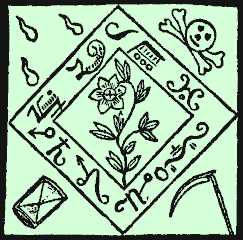
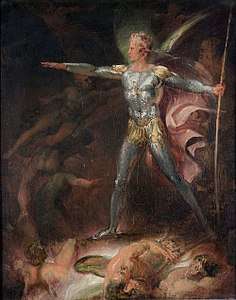
Theistic Luciferian groups are particularly inspired by Lucifer (from the Latin for ‘bearer of light’), who they may or may not equate with Satan. While some theologians believe the Son of the Dawn, Lucifer, and other names were actually used to refer to contemporary political figures, such as a Babylonian King, rather than a single spiritual entity[27][28] (although on the surface the Bible explicitly refers to the King of Tyrus), those that believe it refers to Satan infer that by implication it also applies to the fall of Satan.[29]
Some writers equate the veneration of Set by the Temple of Set to theistic Satanism.[1] However, the Temple of Set do not identify as theistic Satanists. They believe the Egyptian deity Set is the real Dark Lord behind the name Satan, of whom Satan is just a caricature. Their practices primarily center on self-development. Within the temple of Set, the Black Flame is the individual's god-like core which is a kindred spirit to Set, and they seek to develop. In theistic Satanism, the Black Flame is knowledge which was given to humanity by Satan, who is a being independent of the Satanist himself[30] and which he can dispense to the Satanist who seeks knowledge.[1]
Some groups are mistaken by scholars for theistic Satanists, such as the First Church of Satan.[1] However, the founder of the FCoS considers what he calls "devil-worship" to often be a symptom of psychosis.[31] Other groups such as the 600 Club,[2] are accepting of all types of Satanist, as are the Sinagogue of Satan, which aims for the ultimate destruction of religions, paradoxically including itself, and encourages not self-indulgence, but self-expression balanced by social responsibility.[32][33][34]
The diversity of beliefs amongst Satanists, and the theistic nature of some Satanists, was seen in a survey in 1995. Some spoke of seeing Satan not as someone dangerous to those who seek or worship him, but as someone that could be approached as a friend. Some refer to him as Father, though some other theistic Satanists consider that to be confused or excessively subservient.[35] Satan is also portrayed as a father to his daughter, Sin, by Milton in Paradise Lost.
Values in theistic Satanism
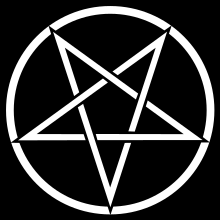
Seeking knowledge is seen by some theistic Satanists as being important to Satan, due to Satan being equated with the serpent in Genesis, which encouraged humans to partake of the fruit of the Tree of Knowledge of Good and Evil.[36] Some perceive Satan as Éliphas Lévi's conception of Baphomet — a hermaphroditic bestower of knowledge (gnosis). Some Satanic groups, such as Luciferians, also seek to gain greater gnosis.[22] Some of such Satanists, such as the former Ophite Cultus Satanas, equate Yahweh with the demiurge of Gnosticism, and Satan with the transcendent being beyond.[22]
Self-development is important to theistic Satanists. This is due to the Satanists' idea of Satan, who is seen to encourage individuality and freedom of thought, and the quest to raise one's self up despite resistance, through means such as magic and initiative. They believe Satan wants a more equal relationship with his followers than the Abrahamic God does with his. From a theistic Satanist perspective, the Abrahamic religions (chiefly Christianity) do not define "good" or "evil" in terms of benefit or harm to humanity, but rather on the submission to or rebellion against God.[37] Some Satanists seek to remove any means by which they are controlled or repressed by others and forced to follow the herd, and reject non-governmental authoritarianism.[38]
As Satan in the Old Testament tests people, theistic Satanists may believe that Satan sends them tests in life in order to develop them as individuals. They value taking responsibility for oneself. Despite the emphasis on self-development, some theistic Satanists believe that there is a will of Satan for the world and for their own lives. They may promise to help bring about the will of Satan,[39] and seek to gain insight about it through prayer, study, or magic. In the Bible, a being called "the god of this world" is mentioned in the Second Epistle to the Corinthians 4:4, which Christians typically equate with Satan.[40] Some Satanists therefore think that Satan can help them meet their worldly needs and desires if they pray or work magic. They would also have to do what they could in everyday life to achieve their goals, however.
Theistic Satanists may try not to project an image that reflects negatively on their religion as a whole and reinforces stereotypes, such as promoting Nazism, abuse, or crime.[38] However, some groups, such as the Order of Nine Angles, criticize the emphasis on promoting a good image for Satanism; the ONA described LaVeyan Satanism as "weak, deluded and American form of 'sham-Satanic groups, the poseurs'",[41] and ONA member Stephen Brown claimed that "the Temple of Set seems intent only on creating a 'good public impression', with promoting an 'image'".[42] The order emphasises that its way "is and is meant to be dangerous"[43] and "[g]enuine Satanists are dangerous people to know; associating with them is a risk".[44] Similarly, the Temple of the Black Light has criticized the Church of Satan, and has stated that the Temple of Set is "trying to make Setianism and the ruler of darkness, Set, into something accepted and harmless, this way attempting to become a 'big' religion, accepted and acknowledged by the rest of the Judaeo-Christian society".[22] The TotBL rejects Christianity, Judaism and Islam as "the opposite of everything that strengthens the spirit and is only good for killing what little that is beautiful, noble and honorable in this filthy world".[22]
There is argument among Satanists over animal sacrifice, with most groups seeing it as both unnecessary and putting Satanism in a bad light, and distancing themselves from the few groups that practice it, such as the Temple of the Black Light.[45]
Theistic Satanism often involves a religious commitment, rather than being simply an occult practice based on dabbling or transient enjoyment of the rituals and magic involved.[46] Practitioners may choose to perform a self-dedication rite, although there are arguments over whether it is best to do this at the beginning of their time as a theistic Satanist, or once they have been practicing for some time.[47][48]
Historical mentions of Satanism
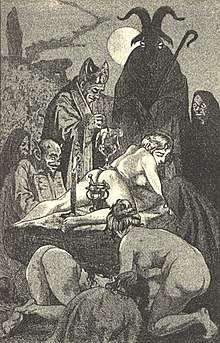
The worship of Satan was a frequent charge against those charged in the witch trials in Early Modern Europe and other witch-hunts such as the Salem witch trials.[49] The charge of Satan worship has also been made against groups or individuals regarded with suspicion, such as the Knights Templar, or minority religions.[50] In the case of the Knights Templar, the Templars' writings mentioned the word 'Baphomet', which was a French corruption of the name 'Mohammed' (the prophet of the people who the Templars fought against), and that 'Baphomet' was falsely portrayed as a demon by the people who accused the Templars.
It is not known to what extent accusations of groups worshiping Satan in the time of the witch trials identified people who did consider themselves Satanists, rather than being the result of religious superstition or mass hysteria, or charges made against individuals suffering from mental illness. Confessions are unreliable, particularly as they were usually obtained under torture.[51] However, scholar Jeffrey Burton Russell, Professor Emeritus of the University of California at Santa Barbara, has made extensive arguments in his book Witchcraft in the Middle Ages[52] that not all witch trial records can be dismissed and that there is in fact evidence linking witchcraft to gnostic heresies. Russell comes to this conclusion after having studied the source documents themselves. Individuals involved in the Affair of the Poisons were accused of Satanism and witchcraft.
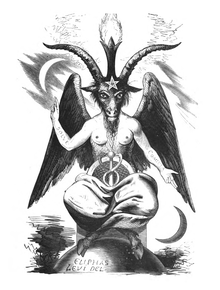
Historically, Satanist was a pejorative term for those with opinions that differed from predominant religious or moral beliefs.[53] Paul Tuitean believes the idea of acts of "reverse Christianity" was created by the Inquisition,[54] but George Bataille believes that inversions of Christian rituals such as the Mass may have existed prior to the descriptions of them which were obtained through the witchcraft trials.[55]
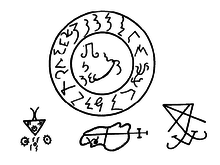
In the 18th century various kinds of popular "Satanic" literature began to be produced in France, including some well-known grimoires with instructions for making a pact with the Devil. Most notable are the Grimorium Verum and The Grand Grimoire. The Marquis de Sade describes defiling crucifixes and other holy objects, and in his novel Justine he gives a fictional account of the Black Mass,[56] although Ronald Hayman has said Sade's need for blasphemy was an emotional reaction and rebellion from which Sade moved on, seeking to develop a more reasoned atheistic philosophy.[57] In the 19th century, Eliphas Levi published his French books of the occult, and in 1855 produced his well-known drawing of the Baphomet which continues to be used by some Satanists today. That Baphomet drawing is the basis of the sigil of Baphomet, which was first adopted by the non-theistic Satanist group called the Church of Satan.[58]
Finally, in 1891, Joris-Karl Huysmans published his Satanic novel, Là-bas, which included a detailed description of a Black Mass which he may have known firsthand was being performed in Paris at the time,[59] or the account may have been based on the masses carried out by Étienne Guibourg, rather than by Huysmans attending himself.[60] Quotations from Huysmans' Black Mass are also used in some Satanic rituals to this day, since it is one of the few sources that purports to describe the words used in a Black Mass. The type of Satanism described in Là-bas suggests that prayers are said to the Devil, hosts are stolen from the Catholic Church, and sexual acts are combined with Roman Catholic altar objects and rituals, to produce a variety of Satanism which exalts the Devil and degrades the God of Christianity by inverting Roman Catholic rites. George Bataille claims that Huysman's description of the Black Mass is "indisputably authentic".[55] Not all theistic Satanists today routinely perform the Black Mass, possibly because the Mass is not a part of modern evangelical Christianity in Protestant countries[61] and so not such an unintentional influence on Satanist practices in those countries.
The earliest verifiable theistic Satanist group was a small group called the Ophite Cultus Satanas, which was created in Ohio in 1948. The Ophite Cultus Satanas was inspired by the ancient Ophite sect of Gnosticism, and the Horned God of Wicca. The group was dependent upon its founder and leader, and therefore dissolved after his death in 1975.
Michael Aquino published a rare 1970 text of a Church of Satan Black Mass, the Missa Solemnis, in his book The Church of Satan,[62] and Anton LaVey included a different Church of Satan Black Mass, the Messe Noire, in his 1972 book The Satanic Rituals. LaVey's books on Satanism, which began in the 1960s, were for a long time the few available which advertised themselves as being Satanic, although others detailed the history of witchcraft and Satanism, such as The Black Arts by Richard Cavendish published in 1967 and the classic French work Satanism and Witchcraft, by Jules Michelet. Anton LaVey specifically denounced "devil worshippers" and the idea of praying to Satan.
Although non-theistic LaVey Satanism had been popular since the publication of The Satanic Bible in 1969, theistic Satanism did not start to gain any popularity until the emergence of the Order of Nine Angles in western England, and its publication of The Black Book of Satan in 1984.[63] The next theistic Satanist group to be created was the Misanthropic Luciferian Order, which was created in Sweden in 1995. The MLO incorporated elements from the Order of Nine Angles, the Illuminates of Thanateros and Qliphothic Qabalah.
Modern-day public image of Satanism and moral panics
As a moral panic in the 1980s and the 1990s, there were multiple allegations of sexual abuse and/or sacrifice of children or non-consenting adults in the context of Satanic rituals in what has come to be known as the Satanic Panic.[64] Allegations included the existence of large networks of organized Satanists involved in illegal activities such as murder, child pornography and prostitution. In the United States, the Kern County child abuse cases, McMartin preschool trial and the West Memphis cases were widely reported. One case took place in Jordan, Minnesota, in which children made allegations of the manufacture of child pornography, ritualistic animal sacrifice, coprophagia, urophagia and infanticide, at which point the Federal Bureau of Investigation (FBI) was alerted. Twenty-four adults were arrested and charged with acts of sexual abuse, child pornography and other crimes claimed to be related to Satanic ritual abuse; three went to trial, two were acquitted and one convicted. Supreme Court Justice Scalia noted in a discussion of the case that "[t]here is no doubt that some sexual abuse took place in Jordan; but there is no reason to believe it was as widespread as charged", and cited the repeated, coercive techniques used by the investigators as damaging to the investigation.[65]
These iconic cases were launched after children were repeatedly and coercively interrogated by social workers, resulting in false allegations of child sexual abuse. No evidence was ever found to support any of the allegations of Satanism or ritual abuse, but the panic resulted in numerous wrongful prosecutions.
Between 1992 and 1996, some militant Neo-Pagans who were participants in the early Norwegian black metal scene, such as Varg Vikernes,[66] committed over fifty arsons of Christian churches in and around Oslo as a retaliatory action against Christianity in Norway, but such church-burnings were widely attributed to Satanists.[67]
Some studies of crimes have also looked at the theological perspective of those who commit religious or ritualized crime.[68] Criminals who explain their crimes by claiming to be Satanists have been said by sociologists to be "pseudo-Satanists",[3] and attempts to link Satanism to crime have been seen by theistic Satanists as scaremongering.[69]
See also
References
- Partridge 2004, p. 82.
- Petersen 2005, p. 429.
- Gallagher 2004, p. 190.
- Petersen 2005, p. 438.
- Introvigne 2016, pp. 370-371.
- Petersen 2005, p. 442.
- Lewis, James R. (August 2001). "Who Serves Satan? A Demographic and Ideological Profile". Marburg Journal of Religion. University of Marburg. 6 (2). doi:10.17192/mjr.2001.6.3748. ISSN 1612-2941. Retrieved 26 June 2020.
- Archived Cathedral of the Black Goat 'Views' Page
- Metzger, Richard; Morrison, Grant (2003). Book of Lies: The Disinformation Guide to Magick and the Occult. The Disinformation Company. p. 266. ISBN 9780971394278. Retrieved 5 June 2008.
- High Priest, Magus Peter H. Gilmore. "Satanism: The Feared Religion". churchofsatan.com.
- Susej, Tsirk (2007). The Demonic Bible. p. 11. ISBN 9781411690738. Retrieved 12 May 2008.
- Ford, Michael (2017). The Bible of the Adversary Anniversary Edition. Houston, Texas: Succubus Productions Publishing. p. 16. ISBN 9781979202596.
- Introvigne, Massimo (13 April 2017). "Satan the Prophet: A History of Modern Satanism" (PDF). CESNUR. p. 55. Retrieved 26 June 2020.
- "National Socialist Movement". SPLCenter.org. Southern Poverty Law Center. 2020. Retrieved 26 June 2020.
The NSM has had its share of movement scandal. In July 2006, it was rocked by revelations that co-founder and chairman emeritus Cliff Herrington’s wife was the “High Priestess” of the Joy of Satan Ministry, and that her satanic church shared an address with the Tulsa, Okla., NSM chapter. The exposure of Herrington’s wife’s Satanist connections caused quite a stir, particularly among those NSM members who adhered to a racist (and heretical) variant of Christianity, Christian Identity. Before the dust settled, both Herringtons were forced out of NSM. Bill White, the neo-Nazi group’s energetic spokesman, also quit, taking several NSM officials with him to create a new group, the American National Socialist Workers Party.
- "The National Socialist Movement". Adl.org. New York: Anti-Defamation League. 2020. Retrieved 26 June 2020.
- Editors (27 September 2019). "Satanism - Founders, Philosophies & Branches". History.com. A&E Networks. Retrieved 26 June 2020.CS1 maint: extra text: authors list (link)
- "The Religious Movements Homepage". virginia.edu. Archived from the original on 29 August 2006.
- Lewis 2001a, p. 234.
- Lewis 2001a, p. 240.
- "DEVIL WORSHIP". theisticsatanism.com.
- "SATANISM CENTRAL: Answers to All Your Questions". churchofsatan.org.
- "Interview_MLO". Angelfire.com. Retrieved 30 November 2011.
- "Dissection. Interview with Jon Nödtveidt. June 2003". Metal Centre. Archived from the original on 14 July 2011. Retrieved 30 November 2011.
- "Official Dissection Website :: Reinkaos". Dissection.nu. Archived from the original on 8 February 2008.
- "Dissection Frontman Jon Nödtveidt Commits Suicide". Metal Storm. 18 August 2006. Retrieved 30 November 2011.
- "Dissection Guitarist: Jon Nödtveidt Didn't Have Copy of 'The Satanic Bible' at Suicide Scene". Blabbermouth. 23 August 2006. Archived from the original on 27 September 2011. Retrieved 30 November 2011.
- "Lucifer King Of Babylon". realdevil.info.
- Satan, Devil and Demons - Isaiah 14:12-14
- "CATHOLIC ENCYCLOPEDIA: Devil". newadvent.org.
- Ford, Michael (2005). Luciferian Witchcraft. p. 373. ISBN 9781411626386. Retrieved 5 June 2008.
- Is Devil Worship a Symptom of Psychosis? by High Priest John Allee
- Mathews 2009, p. 92.
- Brown, Seth (2004). Think You're the Only One? Oddball Groups Where Outsiders Fit In. Barnes and Noble. pp. 99–100. ISBN 0760757089.
- John, Mitchell (2009). "Local writer compiles directory of unusual organizations".
- Pike, Randall (2007). The Man with Confused Eyes. ISBN 9781411682085. Retrieved 12 May 2008.
- Partridge 2004, p. 228.
- "Elliot Rose on "Evil"". theisticsatanism.com.
- Petersen 2005, pp. 446-447.
- Mickaharic, Draja (1995). Practice of Magic: An Introductory Guide to the Art. Weiser. p. 62. ISBN 9780877288077. Retrieved 24 May 2008.
- Ladd, George Eldon (1993). A Theology of the New Testament. p. 333. ISBN 9780802806802. Retrieved 12 May 2008.
- Commentary on Dreamers of the Dark Archived 24 January 2012 at the Wayback Machine.
- Stephen Brown: The Satanic Letters of Stephen Brown: St. Brown to Dr. Aquino (online version Archived 13 January 2012 at the Wayback Machine).
- The True Way of the ONA Archived 2 July 2011 at the Wayback Machine.
- Satanism: The Epitome of Evil Archived 2 July 2011 at the Wayback Machine.
- "Animal Sacrifice and the Law". theisticsatanism.com.
- Partridge 2004, p. 83.
- "Pacts and self-initiation". theisticsatanism.com.
- "Dissection Frontman Jon Nödtveidt Commits Suicide". Metal Storm. 18 August 2006. Retrieved 30 November 2011.
- Klaits 1985, p. 2.
- Klaits 1985, p. 25.
- Klaits 1985, p. 11.
- Witchcraft in the Middle Ages - Jeffrey Burton Russell - Google Books. Retrieved 13 August 2012.
- Behrendt, Stephen C. (1983). The Moment of Explosion: Blake and the Illustration of Milton. U of Nebraska Press. p. 437. Retrieved 6 June 2008.
- Tuitean, Paul; Daniels, Estelle (1998). Pocket Guide to Wicca. The Crossing Press. p. 22. ISBN 9780895949042. Retrieved 5 June 2008.
- Bataille, George (1986). Erotism: Death and Sensuality. Dalwood, Mary (trans.). City Lights. p. 126. ISBN 9780872861909. Retrieved 21 May 2008.
- Sade, Donatien (2006). The Complete Marquis De Sade. Holloway House. pp. 157–158. ISBN 9780870679407. Retrieved 22 May 2008.
- Hayman, Ronald (2003). Marquis de Sade: The Genius of Passion. Tauris Parke. pp. 30–31. ISBN 9781860648946. Retrieved 21 May 2008.
- http://www.churchofsatan.com/images/church-of-satan-logo-black.png
- Huysmans, Joris-Karl (1972). La Bas. Keene Wallace (trans.). Courier Dover. back cover. ISBN 9780486228372. Retrieved 21 May 2008.
- Laver, James (1954). The First Decadent: Being the Strange Life of J.K. Huysmans. Faber and Faber. p. 121.
- Christiano, Kevin; William H. Swatos; Kivisto, Peter (2001). Sociology of Religion: Contemporary Developments. Rowman Altamira. p. 319. ISBN 9780759100350. Retrieved 7 June 2008.
- Aquino, Michael (2002). The Church of Satan., Appendix 7.
- The Black Book of Satan. 1984, Thormynd Press, ISBN 0-946646-04-X. British Library General Reference Collection Cup.815/51, BNB GB8508400
- Frankfurter, D (2006). Evil Incarnate: Rumors of Demonic Conspiracy and Ritual Abuse in History. Princeton, NJ: Princeton University Press. ISBN 0-691-11350-5.
- Maryland v. Craig, 497 U.S. 836 (1990)
- Moynihan & Søderlind 2003, p. 220.
- Moynihan & Søderlind 2003, p. 89.
- Yonke, David (2006). Sin, Shame, and Secrets: The Murder of a Nun, the Conviction of a Priest. p. 150. ISBN 9780826417558. Retrieved 12 May 2008.
- "Dawn Perlmutter and her Institute for the Research of Organized and Ritual Violence". theisticsatanism.com.
Bibliography
- Dyrendal, Asbjørn (2016). "Satanism in Norway". In Bogdan, Henrik; Hammer, Olav (eds.). Western Esotericism in Scandinavia. Brill Esotericism Reference Library. Leiden: Brill Publishers. pp. 481–488. ISBN 978-90-04-30241-9. ISSN 2468-3566. Retrieved 28 May 2020.CS1 maint: ref=harv (link)
- Gallagher, Eugene V. (2004). "New Foundations". The New Religious Movements Experience in America. Westport, Connecticut: Greenwood Press. pp. 187–196. ISBN 0-313-32807-2. Retrieved 28 May 2020.CS1 maint: ref=harv (link)
- Introvigne, Massimo (2016). Satanism: A Social History. Leiden: Brill Publishers. ISBN 978-90-04-28828-7. Retrieved 28 May 2020.CS1 maint: ref=harv (link)
- Klaits, Joseph (1985). Servants of Satan: The Age of the Witch Hunts. Bloomington, Indiana: Indiana University Press. ISBN 0-253-20422-4. Retrieved 28 May 2020.CS1 maint: ref=harv (link)
- Lewis, James R. (2001a). Satanism Today: An Encyclopedia of Religion, Folklore, and Popular Culture. Santa Barbara, California: ABC-CLIO. ISBN 978-1-57607-292-9. Retrieved 28 May 2020.CS1 maint: ref=harv (link)
- Mathews, Chris (2009). Modern Satanism: Anatomy of a Radical Subculture. Westport, Connecticut: Praeger Publishers. ISBN 978-0-313-36639-0. Retrieved 28 May 2020.CS1 maint: ref=harv (link)
- Moynihan, Michael; Søderlind, Didrik (2003) [1998]. Lords of Chaos: The Bloody Rise of the Satanic Metal Underground (Revised and expanded ed.). Port Townsend, Washington: Feral House. ISBN 0-922915-94-6.CS1 maint: ref=harv (link)
- Partridge, Christopher (2004). The Re-Enchantment of the West: Alternative Spiritualities, Sacralization, Popular Culture, and Occulture. 1. London: T&T Clark. ISBN 0-567-08269-5. Retrieved 28 May 2020.CS1 maint: ref=harv (link)
- Petersen, Jesper Aagaard (2005). "Modern Satanism: Dark Doctrines and Black Flames". In Lewis, James R.; Petersen, Jesper Aagaard (eds.). Controversial New Religions. New York: Oxford University Press. pp. 423–458. ISBN 0-19-515682-X. Retrieved 28 May 2020.CS1 maint: ref=harv (link)
- Petersen, Jesper Aagaard (2014). "From Book to Bit: Enacting Satanism Online". In Asprem, Egil; Granholm, Kennet (eds.). Contemporary Esotericism. Abingdon, Oxford: Routledge. pp. 134–158. ISBN 978-1-908049-32-2. Retrieved 28 May 2020.CS1 maint: ref=harv (link)
- Petersen, Jesper Aagaard, ed. (2016) [2009]. Contemporary Religious Satanism: A Critical Anthology. Abingdon, Oxford: Routledge. ISBN 978-0-7546-5286-1.CS1 maint: ref=harv (link)
- Russell, Jeffrey Burton (1972). Witchcraft in the Middle Ages. Ithaca, New York: Cornell University Press. ISBN 0-8014-0697-8. Retrieved 28 May 2020.CS1 maint: ref=harv (link)
- van Luijk, Ruben (2016). Children of Lucifer: The Origins of Modern Religious Satanism. Oxford Studies in Western Esotericism. New York: Oxford University Press. ISBN 978-0-19-027512-9. Retrieved 28 May 2020.CS1 maint: ref=harv (link)
Further reading
- Ellis, Bill, Raising the Devil: Satanism, New Religions and the Media (Lexington: University Press of Kentucky, 2000).
- Hertenstein, Mike; Jon Trott, Selling Satan: The Evangelical Media and the Mike Warnke Scandal (Chicago: Cornerstone, 1993).
- Brown, Seth; Think you're the only one? (Barnes & Noble Books 2004)
- Medway, Gareth J.; The Lure of the Sinister: The Unnatural History of Satanism (New York and London: New York University Press, 2001).
- Michelet, Jules, Satanism and Witchcraft: A Study in Medieval Superstition (English translation of 1862 French work).
- Palermo, George B.; Michele C. Del Re: Satanism: Psychiatric and Legal Views (American Series in Behavioral Science and Law) . Charles C Thomas Pub Ltd (November 1999)
- Pike, Albert, Morals and Dogma (1871)
- Richardson, James T.; Joel Best; David G. Bromley, The Satanism Scare (New York: Aldine de Gruyter, 1991).
- Vera, Diane, Theistic Satanism: The new Satanisms of the era of the Internet
- Karlsson, Thomas (February 2008). Qabalah, Qliphoth and Goetic Magic. ISBN 978-0-9721820-1-0.
- Ford, Michael (March 2005). Luciferian Witchcraft. ISBN 1-4116-2638-9.
- Baddeley, Gavin; Lucifer Rising, A Book of Sin, Devil Worship and Rock 'n' Roll (Plexus Publishing, November 1999)
- Webb, Don (March 1999). Uncle Setnakt's Essential Guide to the Left Hand Path. ISBN 1-885972-10-5.
- Zacharias, Gerhard (1980). The Satanic Cult. ISBN 0-04-133008-0. Translated from the German Satanskult und Schwarze Messe by Christine Trollope.